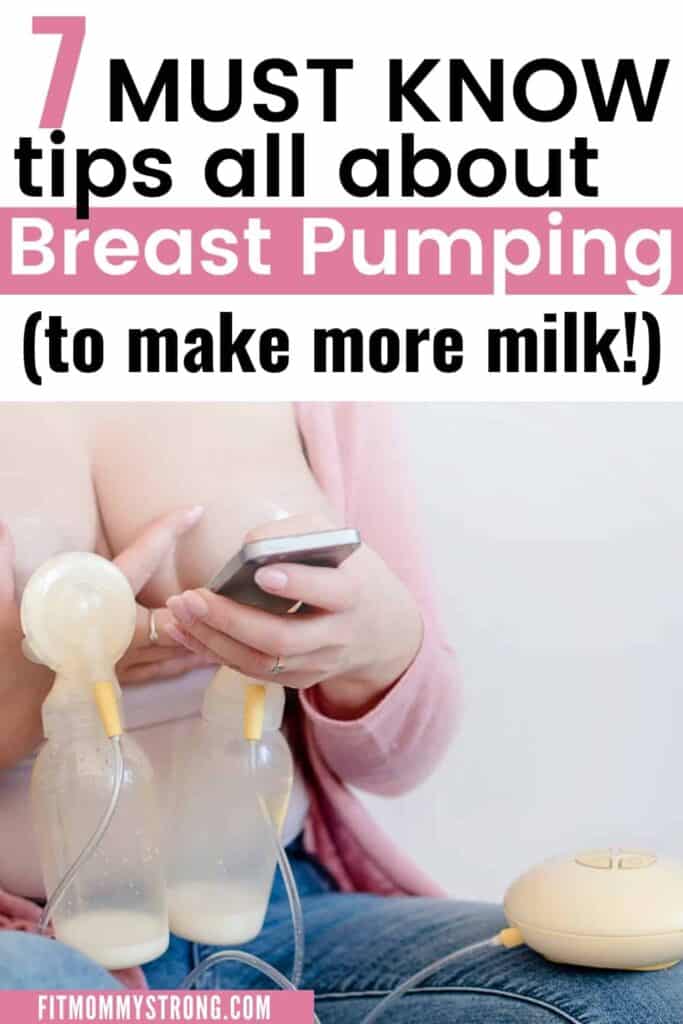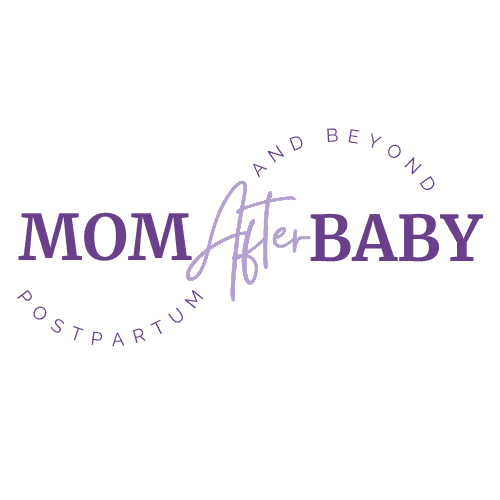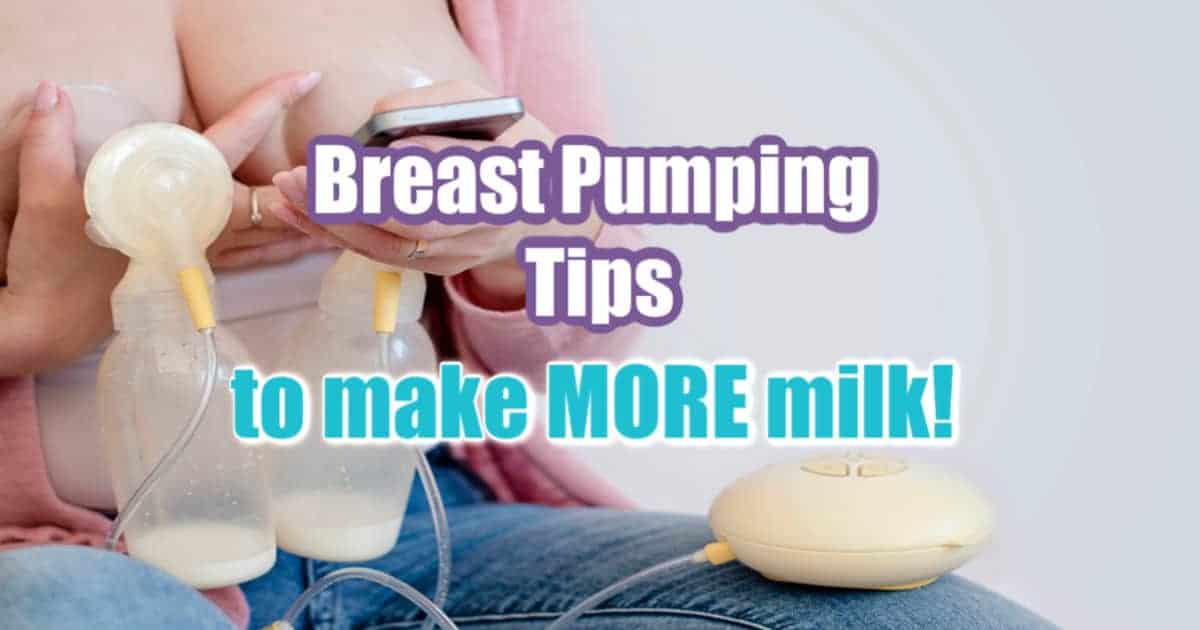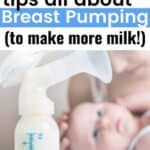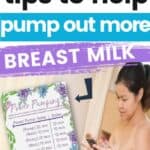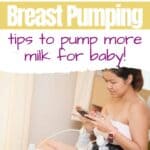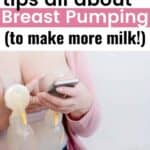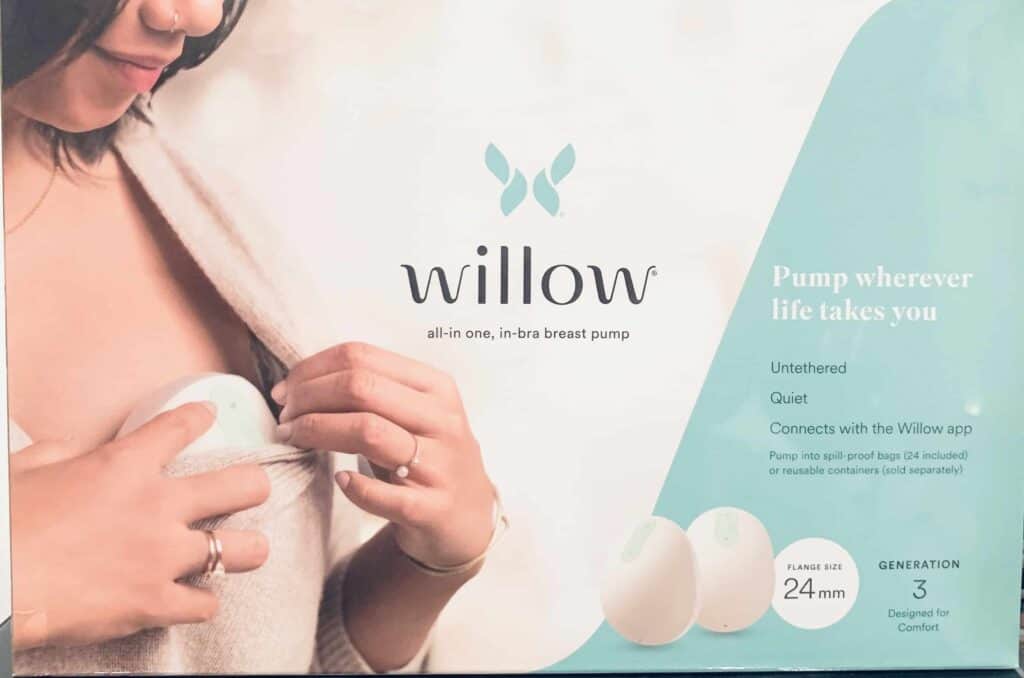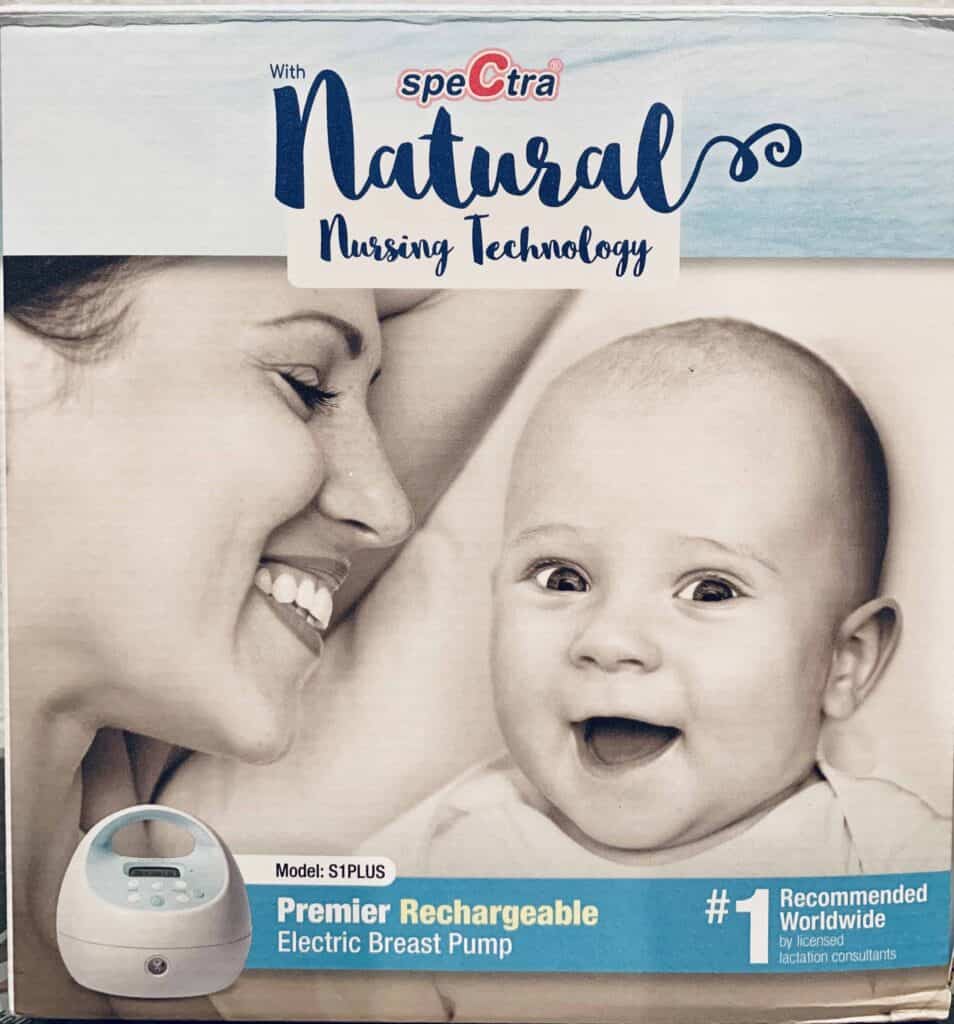Breast pumping tips to get more milk
This post may contain affiliate links that I may receive a commission from if you click & buy. In addition, the information on this site is NOT intended to be medical advice. See my full policy for more information.
As a mama who has pumped AND nursed twice — currently with baby number two — I know how important it is to want to keep your breast milk supply!
If you’re a working mama, have a baby in the NICU or have any reason to rely on breast pumping to provide those nutrients to your baby, that need may feel magnified.
I’ll be honest, when I first started pumping, I came across what I thought were great tips & advice that turned out to be not so great after all.
Hence why I took it upon myself to learn as much as I could about breastfeeding AND pumping so that I could have a successful breastfeeding journey with my son despite all the challenges we faced.
If you’re ready for breast pumping tips to help you get more milk out of each session, let’s dive right in!

1) Use a quality breast pump
Yup, you heard that right! Using a high-quality breast pump could be a game changer as to whether or not you’re able to pump out more milk!
Why it matters?
First things first, when it comes to choosing a breast pump, it is NOT recommended to purchase a used one (especially if it’s an open-system pump).
However, unfortunately some moms cannot afford to pay full price for some of the higher quality pumps. If you’re in this situation, here are some solutions for you to look into:
- Contact your insurance company to see if and what they will cover
- Check Aeroflow Breastpumps (for insurance covered/discounted pumps)
- Check MilkMoms (for insurance covered/discounted pumps)
The next thing you’ll want to focus on is the type of system & suction of the breast pump.
As mentioned above, a “CLOSED SYSTEM” breast pump is typically most ideal because it contains a closed barrier that separates and prevents your milk from overflowing or backing up into the pumping mechanism. Not only does this keep your pump working effectively throughout its lifetime, but it also serves as a big hygienic benefit.
On the other end, an “OPEN SYSTEM” breast pump does not provide that barrier. This increases the risk that your breast milk could potentially get into the machine either ruining it or getting stuck to where it’s impossible to properly cleanout. Although the risk is considered pretty small, it’s still something to consider.
The suction of the pump matters because you want to choose one that is strong enough to signal your body to create/increase breastmilk production (especially if you’re exclusively pumping). The average pump ranges in suction from 225-350 mmHg.
In addition to suction strength, the pumps will typically have a “stimulation” mode which is to help bring you to a letdown. It will also have an “expression” mode which is the mode you use after your letdown begins.
What is the best breast pump on the market
Hands-Free Top Pick — Willow Breast Pump (gen3)
The hand’s free Willow Breast Pump is my personal top pick because:
- 100% hands-free pumping
- Discreet design that fits right into your nursing bra
- Option to pump into willow milk bags or reusable containers
- Overall quiet & discreet pumping
- NO SPILL technology allowing you to sit, stand, bend, or lay down
- Has up to 7 levels of suction (highest being 245 mmHg)
- Rechargeable battery lasts up to 5 suctions throughout the day
- BPA FREE
- Comes with a 1-year warranty
- Sensitivity setting for those needing a less intense, more sensitive suction
- Smartphone APP to track volume, set-up, pumping history, etc…
It’s no doubt the Willow Hands-Free Breast Pump (which you can read my FULL review on here) has changed the game for me entirely while breast pumping with a toddler running around the house.
Being able to pump discreetly without any wires or tubing dangling around AND physically move around without worrying about leaks or spills has been such a relief.
I also found that because of this pumps suction level options, I’m always able to fully empty myself which is another weight off my shoulders as a pumping mom!
However, I know not everyone needs a hands-free pump or maybe can’t afford one which is why my 2nd top pick Is listed next!
Electric Breast Pump Top Pick — Spectra S1 Plus Breast Pump
The Spectra Baby S1 Breast Pump is my top pick of all breast pumps for many reasons:
- It is rechargeable, making it a portable pump once charged (though not hands-free, it’s nice to have the option to walk around if needed)
- Closed system breast pump
- Single or double pumping options
- Has up to 12 levels of suction (highest being 270 mmHg)
- Has a built-in night light with various dimming options
- Quiet pump (operates at only 45 decibels)
- Comes with a 2-year warranty
As you can see above, the Spectra Plus S1 model is hands-down my all-time favorite breast pump. I swear, without this pump, I would’ve never been able to nurse/pump for my first son for 15 months despite all the milk supply issues I faced.
However, if portability isn’t a huge deal-breaker for you, they do have another model called the Spectra Plus S2. This model is a little bit cheaper too, but it has to be plugged into the wall in order to use it.
Other awesome breast pumps that can get the job done:
Medela Pump In Style Breast Pump

Benefits:
- Ease of portability
- Closed system breast pump
- Single or double pumping option
- Single knob adjustable speed
- Great for out of US travel (includes convenient dual-voltage for 110-240V)
Bellababy Double Electric Breast Pump

Benefits:
- Small pump making it easy to carry around or tuck into your pocket
- Closed system breast pump
- 9 levels of suction
- HD Touch Screen Display
- Inexpensive compared to many other brands
Lansinoh Smart Pump Double Electric Breast Pump

Benefits:
- Small pump with ergonomic carrying handle
- CLOSED system pump
- Bluetooth connection to track pumping sessions
- Ultra-quiet motor
- 8 suction strength levels
- Includes soft comfort fit flanges
2) Make sure to pump with the correct flange size
Using the correct flange size when pumping is SO IMPORTANT! Many mamas don’t even realize they aren’t using the correct size which can lead to lots of nipple pain, decreased milk output, insufficient pumping, and more!
So how exactly can you find the correct flange size?
Well, depending on the pump you choose, you will want to follow their steps for measuring your nipple to ensure you get the correct flange size for you.
Most sites will provide you with a flange fitting guide, for example you can view the ones listed below:
- Medela – finding the correct flange size
- Lansinoh – finding the best flange
- Spectra Baby – Sizing photo & measuring guide to find the best flange
If you still need more help or are unsure about your flange size, I’d highly encourage you to watch the video below by MommyShark! She does an awesome job visually explaining and showing you how to find your proper fit AND measure for the best flange!
3) Try pumping at night to increase supply
Adding an extra pump at nighttime (after 10 pm) could be an excellent way to make the most of those pumping sessions.
This is especially true if your little one has started sleeping through the night. Likely your breasts are already full and ready to be relieved.
By adding an extra session in at night could be a great way to alarm your body to keep on pumping out that liquid gold!
Also, theres some stipulation that your hormones responsible for producing breast milk tend to peak in the early mornings, taper off throughout the day and begin peaking again overnight!
4) Practice power pumping
Power pumping is a method of pumping to increase the demand for milk which in turn increases your supply.
An example of a power pumping schedule could look like the following:
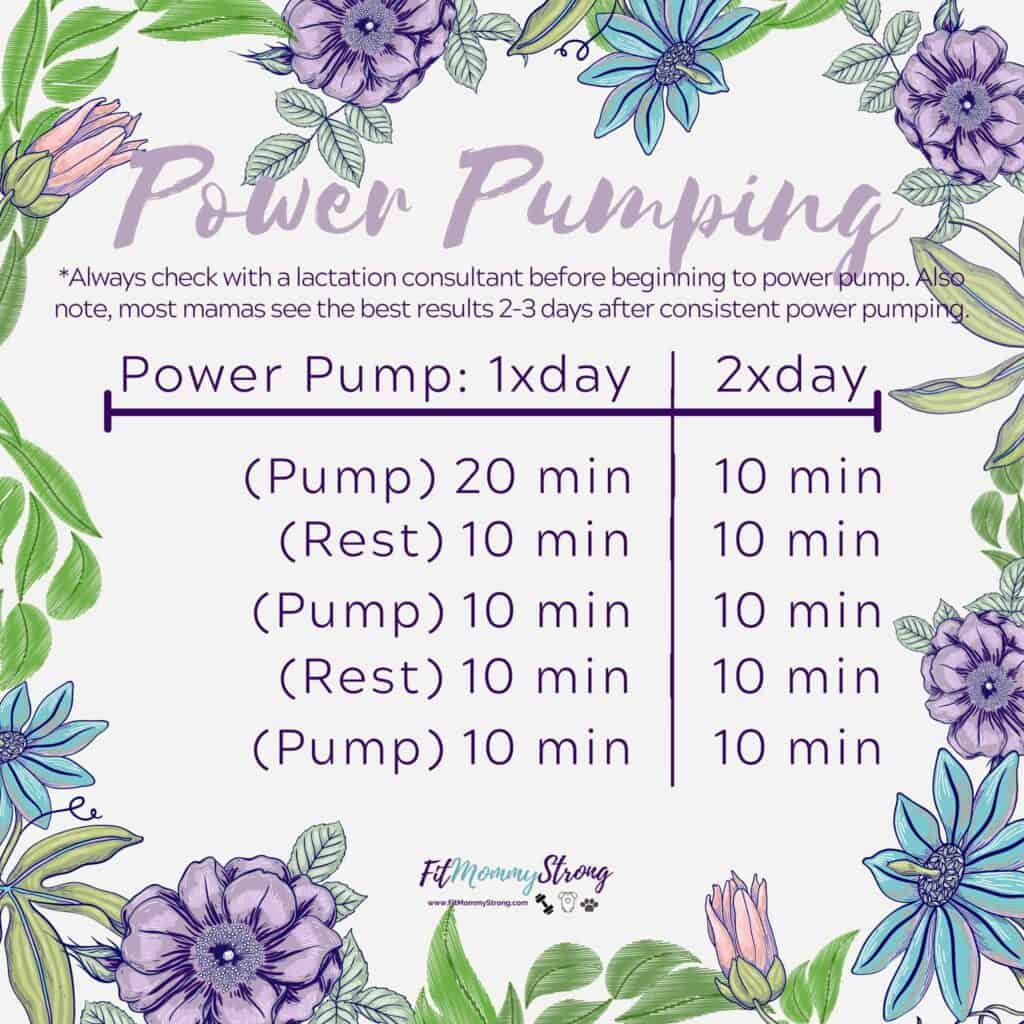
It’s always important to remember that power pumping will take a couple days until you notice any results. When I had begun power pumping due to a low supply, it took me 3 full days before I noticed an increase in my milk output.
Be patient and stay the course if this is the option you choose to go with and also be sure you’re working closely with your lactation consultant throughout the process as well!
5) Use warm compresses when pumping
Warm compressing is such a great tool to use whether you’re a pumping or nursing mama.
You can keep it basic by using a nice warm washcloth, hop in a steamy shower, or use an actual compress made for your breasts!
The benefit to the pre-made compresses is that you can typically use them both hot or cold and if you’re planning to pump for a while, they simply are a little more convenient in my opinion.
The heat from the compress helps to open up those milk ducts and encourage more of a letdown. In turn, allowing you to better empty your breasts efficiently while pumping (or nursing).
I always found doing a 3-5 min compress before I pumped to be very helpful.
Actively massage your breast while pumping
Another tip you can try (something I found helpful as well) is pairing warm compressing with massaging!
The exact way I would do this is I would warm compress for about 3-5 minutes. Then as I got my breast pump connected, I would begin to manually massage each breast to encourage the milk flow!
Whenever I would do this, I would always get a letdown in half the time in comparison to when I didn’t. But hey, sometimes, it’s a lot of work and ya just don’t feel like compressing or massaging, I get it!
Now, I haven’t tried this little handy massager yet, BUT I have heard it’s an absolute game-changer for some mamas! Especially those who have difficulty emptying or who end up with clogged ducts often.

It’s called the LaVie Lactation Massager. It’s a small, handheld massager designed to vibrate and massage your breast to help improve your breast milk flow! It may be worth checking out if all else fails!
6) ALWAYS clean & sanitize your breast pump supplies
Did you know you have to maintain and replace your breast pumping parts every so often?!
Yup, it’s true! Proper maintenance and care of your breast pump is KEY to making sure your pump continues to work in tip-top shape!
Otherwise, you could end up with a pump that begins to lose suction or flat out just stops working.
Some of the common parts you may need to replace are the:
- Duckbill valves
- Pump tubing
- Backflow protectors
- Flanges
- And other pieces dependent on your specific pump
To find out how often you should be replacing these parts, make sure you read your pump’s manual thoroughly for all the top maintenance tips.
In addition to replacing your parts regularly, it’s just as important to wipe down your parts, clean them, and sanitize them in between uses as well.
I use to take apart and clean each piece after every use and then run a sanitizing cycle once a week. Needless to say, my Spectra S1 STILL works perfectly!
And as a helpful tip, using the Medela Sanitizing Bags makes weekly sanitizing SO MUCH EASIER!
7) Lubricate your flanges
This was a little trick I learned from my amazing lactation consultant.
Sometimes, pumping often with those stiff plastic flanges can be super irritating to your nipples, EVEN IF you’re using the correct size!
One way to help minimize that irritation is by lubricating the inside of your flange (the part that your nipple will be centered into). This way, as you pump, the lubrication allows your nipple to glide in smoothly each and every time!
After doing this little trick, I found it helped make pumping a bit more comfortable which allowed me to pump for the full 15-20 minutes at a time and empty myself more efficiently.
For lubrication, you can use just a standard nipple balm (I personally love earth mama nipple butter as seen in the photo below lol), some moms use coconut oil or bamboobies makes an actual pumping lubricant you could try as well.
Related posts you’ll LOVE to read:
>> What’s the deal with Pumping & Dumping? Does it really work?!
>> How to successfully exclusively pump milk for baby!
>> Does caffeine affect your baby while breastfeeding?
Thanks for reading these 7 breast pumping tips to get more milk!
If you found this post helpful, don’t forget to SAVE/SHARE this post to your favorite social media page!
